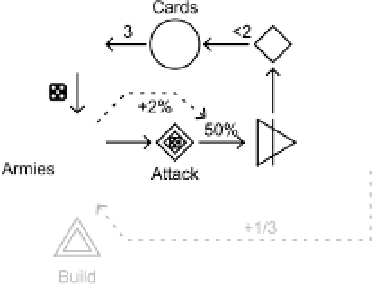Game Development Reference
In-Depth Information
When a player gains a territory, he receives a card. These may be collected into sets
and exchanged for more armies. The second feedback loop in
Risk
is formed by the
cards that are gained from a successful attack (
Figure 6.25
). Only one card can be
gained every turn, so the flow of cards passes through a limiter gate first. Collecting
a set of three cards can be used to generate new armies. The interactive converter
Trade Cards
changes three cards into a random number of armies.
NOTE
in the real
game, not every trio of
cards generates armies,
and some trios gener-
ate more armies than
others. We have simpli-
fied this by making the
exchange rate of cards
for armies random. in
Figure 6.25, this is indi-
cated by the die symbol
labeling the output
of the Trade cards
converter.
FIGURe 6.25
The second feedback loop in
Risk,
involving cards and armies
The third feedback loop is activated when a player manages to capture an entire
continent, which will give the player bonus armies every turn (
Figure 6.26
). In
Risk
,
predefined groups of territories form continents as indicated by the design of the
game board. In the diagram, this level of detail is not possible, so instead the con-
struction is represented as a pool connected to another pool with a node modifier.
In this particular case, five territories count as one continent, which will in turn
activate the bonus source.
FIGURe 6.26
The third feedback loop in
Risk
: bonus armies through
the possession of continents
Finally, the fourth feedback loop is activated by the loss of territories because of the
actions of other players. Which player chooses to attack which other player depends
on many factors, including the attacker's position, strategy, and preferences.









































